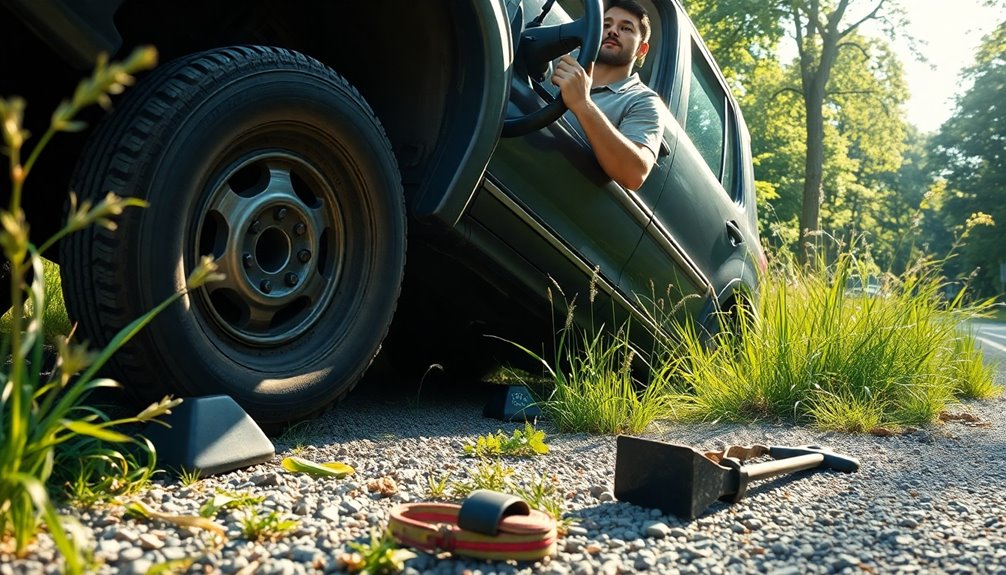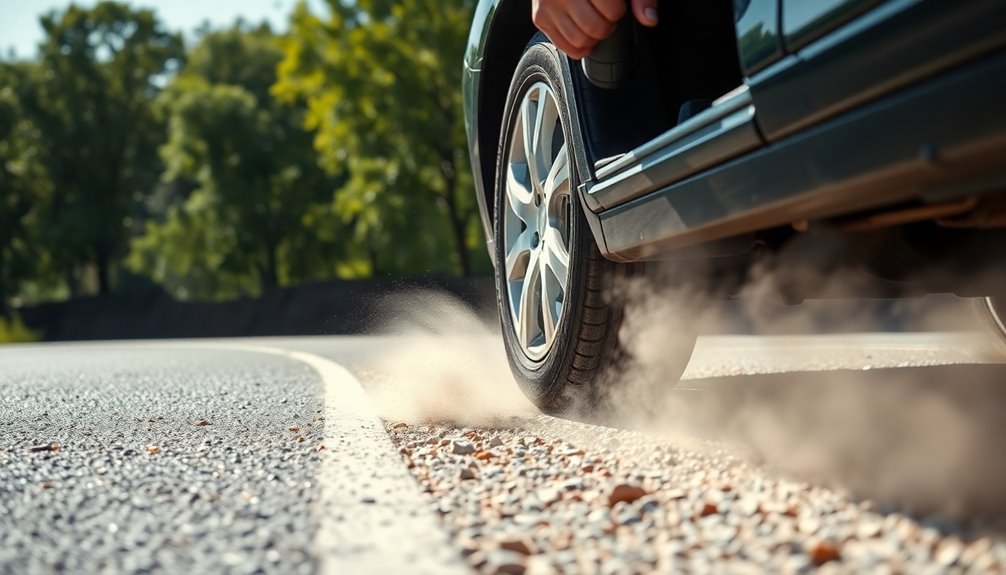When your right wheels veer off the road, stay calm and assess the situation. Gradually ease off the accelerator to slow down and gently steer left to guide your vehicle back into the lane. Keep both hands on the steering wheel for better control and look for oncoming traffic before merging. Make sure to check for obstacles on the shoulder while avoiding distractions. Slow down to 25 MPH or lower for a safer recovery. By maintaining a steady speed and being aware of your surroundings, you enhance your chances of a smooth return—there's more insight ahead on this topic.
Key Takeaways
- Stay calm and grip the steering wheel firmly to maintain control during recovery.
- Gradually ease off the accelerator to reduce your speed safely.
- Check for oncoming traffic before gently steering back into your lane.
- Use small steering adjustments to smoothly realign your vehicle.
- Maintain a steady speed of 25 MPH or lower to minimize accident risks.
Immediate Actions to Take

When your right wheels veer off the road, the first thing you should do is stay calm. This immediate reaction helps you assess the situation without panicking. Take a moment to regain your focus and maintain control of the vehicle. Gradually ease off the accelerator to reduce your speed; sudden movements can lead to a loss of control.
Next, gently steer to the left. This smooth maneuver allows you to realign your vehicle back onto the road while minimizing the risk of rolling over. Keep both hands firmly on the steering wheel for better stability as you navigate back onto the pavement.
Before merging back into your lane, it's essential to check for any oncoming traffic. Verify it's safe to return to the road, as other vehicles could pose a risk if you act too quickly.
Key Safety Measures

To guarantee your safety while recovering your vehicle, it's essential to prioritize key measures that enhance control and awareness. Keeping a calm demeanor is important; panic can lead to poor decisions and loss of control.
Here's what you need to focus on:
- Grip the Steering Wheel: Maintain both hands firmly on the steering wheel. This stability allows you to make precise movements as you steer back onto the road.
- Assess Your Surroundings: Before attempting to re-enter the roadway, carefully check for oncoming traffic. Awareness of your surroundings is fundamental for a safe recovery.
- Reduce Speed Gradually: Avoid hard braking; instead, gently reduce your speed. This helps you maintain traction and minimizes the risk of skidding while making your maneuvers.
As you begin the recovery process, use small steering adjustments to guide your vehicle back onto the road.
By following these key safety measures, you'll be better equipped to regain control and navigate the situation effectively.
Effective Driving Techniques

Recovering your vehicle effectively requires a combination of quick thinking and precise driving techniques.
When your right wheels veer off the road, your first step is to steer left gently to guide your vehicle back onto the pavement. It's essential to maintain a steady speed during this maneuver to prevent loss of control. As you steer, ease off the accelerator gradually; slamming on the brakes can lead to skidding, making the situation worse.
Keep both hands on the steering wheel to guarantee maximum control and make smooth adjustments instead of sudden jerks. These small, deliberate movements will help prevent a rollover or further veering off the road.
Before re-entering the lane, always check for traffic around you. This is critical for a safe return to the roadway.
Importance of Awareness

Awareness plays an essential role in maintaining control of your vehicle, especially when you find yourself drifting off the road. When you stay alert, you can recognize signs of trouble and take corrective action before it's too late. Your ability to monitor your surroundings can make all the difference.
Here are three key reasons why awareness is vital:
- Identify Obstacles: Being aware helps you spot potential dangers on the shoulder, like trees or barriers, allowing you to steer clear of them.
- Traffic Monitoring: Keeping an eye on the vehicles around you enables better decision-making when you need to merge back into traffic safely.
- Avoid Distractions: Staying focused means resisting distractions, like mobile devices or loud music, which can pull your attention away from the road.
When you prioritize awareness, you're not just reacting to drifting; you're proactively controlling your steering and anticipating necessary adjustments.
Speed Management Strategies

Effective speed management is essential when you find yourself off the road, as it directly impacts your ability to regain control. Start by gradually easing off the gas pedal to reduce speed without abrupt braking. This method helps maintain vehicle control during your recovery. Aim to slow down to 25 MPH or lower before attempting to return to the road; this speed is generally safer for re-entry.
Allow the vehicle to decelerate naturally by removing your foot from the accelerator instead of applying hard brakes, which can lead to skidding.
As you prepare for re-entering the roadway, maintaining a steady speed is vital. Sudden movements could result in a loss of control, making your situation even riskier.
Establishing a safe speed before attempting to return to the road minimizes the risk of accidents and enhances overall safety during this important maneuver.
Safe Return to the Road

After slowing down and managing your speed, it's important to focus on re-entering the road safely. Start by checking for a gap in traffic to guarantee a safe merge back onto the roadway. Once you've identified a clear space, it's time to take action.
- Steer with Confidence: Turn the steering wheel approximately one-quarter turn left to align your vehicle with the road as you begin to re-enter.
- Merge Smoothly: Drive back onto the road smoothly and steadily. This helps you maintain control and prevents sudden movements that could lead to skidding.
- Position Yourself Properly: Once you're back on the pavement, steer to the right to properly position your vehicle within your lane.
Always signal your intentions to other drivers when merging back onto the road. This enhances safety and communication, making it clear to others that you're re-entering traffic.
Seeking Assistance When Needed

What should you do if you can't safely return to the road after veering off? First, drive your vehicle as far off the roadway as possible to avoid potential hazards. Park in a safe location away from traffic, where you can assess your situation without worry.
Once you've stopped, it's time to seek assistance. Use your mobile device to call for help. Services like AAA or local roadside assistance can provide the help you need. Be sure to communicate your precise location and the nature of your situation clearly. This information is essential for responders to assist you effectively.
If you feel unsafe exiting your vehicle—especially in high-traffic areas—stay inside with your seatbelt fastened until help arrives. This keeps you protected from any nearby hazards.
When assistance arrives, continue to communicate your needs and provide any additional details that may help them assist you better.
Learning Tools for Recovery

When it comes to learning recovery techniques, effective flashcards can help you memorize essential steps quickly. Additionally, incorporating nutrition-rich foods into your recovery routine can enhance cognitive function and overall well-being. Time management apps can also support your recovery by improving focus and keeping you organized during this process. You'll also benefit from interactive learning platforms that provide real-time Q&A, making the process engaging and informative. Moreover, high vibrational energy is crucial for maintaining motivation and focus during recovery efforts. Plus, practice testing strategies can reinforce what you've learned, ensuring you're prepared for any situation on the road. Additionally, incorporating preparation techniques can significantly reduce anxiety during recovery efforts. Furthermore, utilizing predictive modeling can help identify areas where you may need additional support in your recovery journey.
Effective Flashcard Techniques
While mastering vehicle recovery techniques can seem challenging, using effective flashcard techniques can simplify the learning process. Flashcards are a powerful tool for memorizing essential vehicle recovery steps, like the importance of steering left and gradually reducing speed when you veer off the road.
Here are three compelling reasons to use flashcards:
- Enhanced Learning and Understanding: Customizing flashcards with images or diagrams can clarify steering techniques and vehicle positioning during recovery. Additionally, utilizing diversification strategies in your study methods can enhance retention by exposing you to various learning styles.
- Confidence in Executing Maneuvers: Regularly reviewing flashcards boosts your knowledge retention, making you feel more prepared and confident when it's time to steer back onto the road.
- Collaborative Learning Opportunities: Using flashcards in study groups encourages discussion around recovery strategies and driving safety, reinforcing the concepts together.
Incorporating flashcards into your study routine not only aids in understanding vehicle recovery steps but also fosters a supportive learning environment. Furthermore, developing a growth mindset can help you view challenges in recovery as opportunities to improve your skills.
As you engage with this method, you'll find that your anxiety decreases, and your ability to react effectively in real-life scenarios improves.
Interactive Learning Platforms
Numerous interactive learning platforms are available to enhance your understanding of vehicle recovery techniques. For instance, interactive simulations allow you to practice recovery scenarios in a risk-free environment, helping you master essential steering techniques and speed management.
You can explore various recovery methods without the pressures of real-world situations, making it an invaluable tool for learning.
Online forums and communities also serve as excellent resources, where you can share experiences and gather tips on effective vehicle recovery. Engaging with fellow drivers fosters collaborative learning and encourages the exchange of best practices.
Additionally, mobile apps dedicated to driving safety often feature instant guidance on recovery procedures. These apps enable you to access critical information quickly while on the move, ensuring you're prepared for any off-road situations.
Finally, virtual driving courses incorporate interactive elements to reinforce your knowledge of recovery steps. These courses help build your confidence in handling challenging scenarios, ensuring you're ready to tackle any unexpected detours.
With these interactive learning platforms at your disposal, you'll be well-equipped to navigate your recovery journey safely and effectively.
Practice Testing Strategies
Effective practice testing strategies can greatly bolster your understanding of vehicle recovery techniques. By actively engaging with the material, you'll enhance your ability to manage situations when your wheels veer off the road.
Here are three powerful strategies to reflect on:
- Flashcards: Use them to memorize key recovery techniques, like the importance of steering left and adjusting your speed.
- Matching Exercises: These can help you link terms such as 'counter steering' and 'speed management' with their definitions, improving recall when it matters most.
- Peer Discussions: Engage with others on platforms like Q-Chat to share experiences and refine your understanding through collaborative learning.
Incorporating these practice testing strategies into your routine can markedly improve your understanding retention. Additionally, reviewing concepts such as color accuracy can enhance your ability to assess the situation effectively.
Active learning through summarization and visualization of recovery steps allows you to internalize how to safely realign your vehicle.
Regularly testing your knowledge will identify areas needing improvement while reinforcing critical concepts.
Impact of Weather on Driving

When the weather turns bad, your driving skills face new challenges.
Rain can lead to hydroplaning, while snow and ice dramatically increase the risk of accidents.
It's essential to adjust your speed and following distance to stay safe on the road.
Rain and Hydroplaning Risks
As rain begins to fall, the risk of hydroplaning increases considerably, especially during the first 30 minutes when water mixes with road oils to create a dangerously slippery surface.
When you're driving in these conditions, it's vital to maintain control and traction. Keep in mind:
- Reduce Speed: Slowing down helps your tires maintain better contact with the road.
- Avoid Sudden Steering Movements: Smooth, gentle maneuvers are essential to prevent losing control.
- Increase Following Distance: Wet roads can double your stopping distances, so give yourself extra space.
Snow and Ice Challenges
Snow and ice present serious challenges for drivers, greatly reducing tire traction and increasing the chances of skidding or losing control. When roads are icy, your stopping distances can be up to ten times longer than on dry pavement. This means you need to increase your following distance considerably to avoid accidents.
Black ice, often invisible, can form in shaded areas, catching you off guard and leading to sudden skids. To combat these winter hazards, proper vehicle maintenance is crucial. Investing in winter tires can provide better grip on snow and ice, enhancing your control. Regularly checking your tire pressure guarantees they're performing at their best.
When driving in winter weather, always remember to reduce your speed. Slower speeds give you more time to react to unexpected skids or icy patches. If you do start to skid, steer gently in the direction you want to go and avoid slamming on the brakes. Additionally, maintaining proper vehicle maintenance can significantly improve your overall safety during winter driving conditions.
Vehicle Maintenance Tips

To keep your vehicle running smoothly and guarantee your safety on the road, regular maintenance is essential. Neglecting this can lead to serious issues that compromise both your engine performance and driving safety. Here are a few key tips to help you stay on track:
- Check tire pressure regularly: Under-inflated tires wear unevenly, while over-inflated ones risk blowouts. Both can severely impact your vehicle control.
- Monitor fluid levels: Keep an eye on oil, coolant, and brake fluid. Low fluid levels can lead to decreased performance and potential engine failure.
- Schedule brake and steering inspections: Regularly checking these components guarantees their functionality and enhances your overall driving safety.
If you often face winter storms, consider investing in all-weather tires for better traction and handling.
Don't forget that routine maintenance on your engine can prevent overheating and avoid dangerous situations.
By staying proactive with these maintenance tips, you'll enhance your vehicle's performance and keep yourself safe on the road.
Frequently Asked Questions
What Should You Do if Your Right Wheels Come off the Pavement?
If your right wheels come off the pavement, stay calm and avoid sudden movements.
Steer gently to the left, aiming to align your vehicle back on the road. Gradually ease off the accelerator to reduce your speed to around 25 MPH or less.
Before returning to the road, check for oncoming traffic and verify it's safe.
Use small steering adjustments to guide your vehicle back smoothly and maintain control while doing so.
How Do You Recover From Driving off the Road?
You might think recovering from driving off the road is challenging, but it's manageable.
Start by gently steering left to get back on track, avoiding sudden movements that can cause skidding. Gradually reduce your speed to around 25 MPH, ensuring you're aware of traffic around you.
Use your mirrors to check for a clear gap before merging back onto the road. If it's unsafe, pull over, stop, and call for help if needed.
What Is the First Action You Should Do if Your Right Tire Comes off the Highway?
If your right tire comes off the highway, the first thing you should do is stay calm.
Avoid making any sudden steering movements, as that could lead to losing control. Gradually ease off the accelerator to slow down without hard braking.
Keep your vehicle going straight and gently steer left to guide it back onto the road.
Always check for oncoming traffic before re-entering, ensuring it's safe to do so.
What Should You Do if Your Wheels Slip off the Edge of the Road?
Life's a journey, and sometimes you drift off the main path.
If your wheels slip off the edge, steer left gently to realign with the road.
Don't slam the brakes; instead, ease off the accelerator to slow down gradually.
Check for oncoming traffic, ensuring it's safe to merge back.
Aim for a level spot when re-entering, and keep both hands on the wheel to maintain control.
Stay steady, and you'll find your way back.
Conclusion
When your right wheels veer off the road, staying calm is essential. Remember, with a steady grip on the wheel and your eyes focused ahead, you can navigate back to safety. It's like pulling a stubborn bull back to the herd—challenging but completely doable! Always prioritize awareness and adjust your speed, and don't hesitate to ask for help if you're unsure. With practice and the right mindset, you'll conquer any road challenges that come your way.









